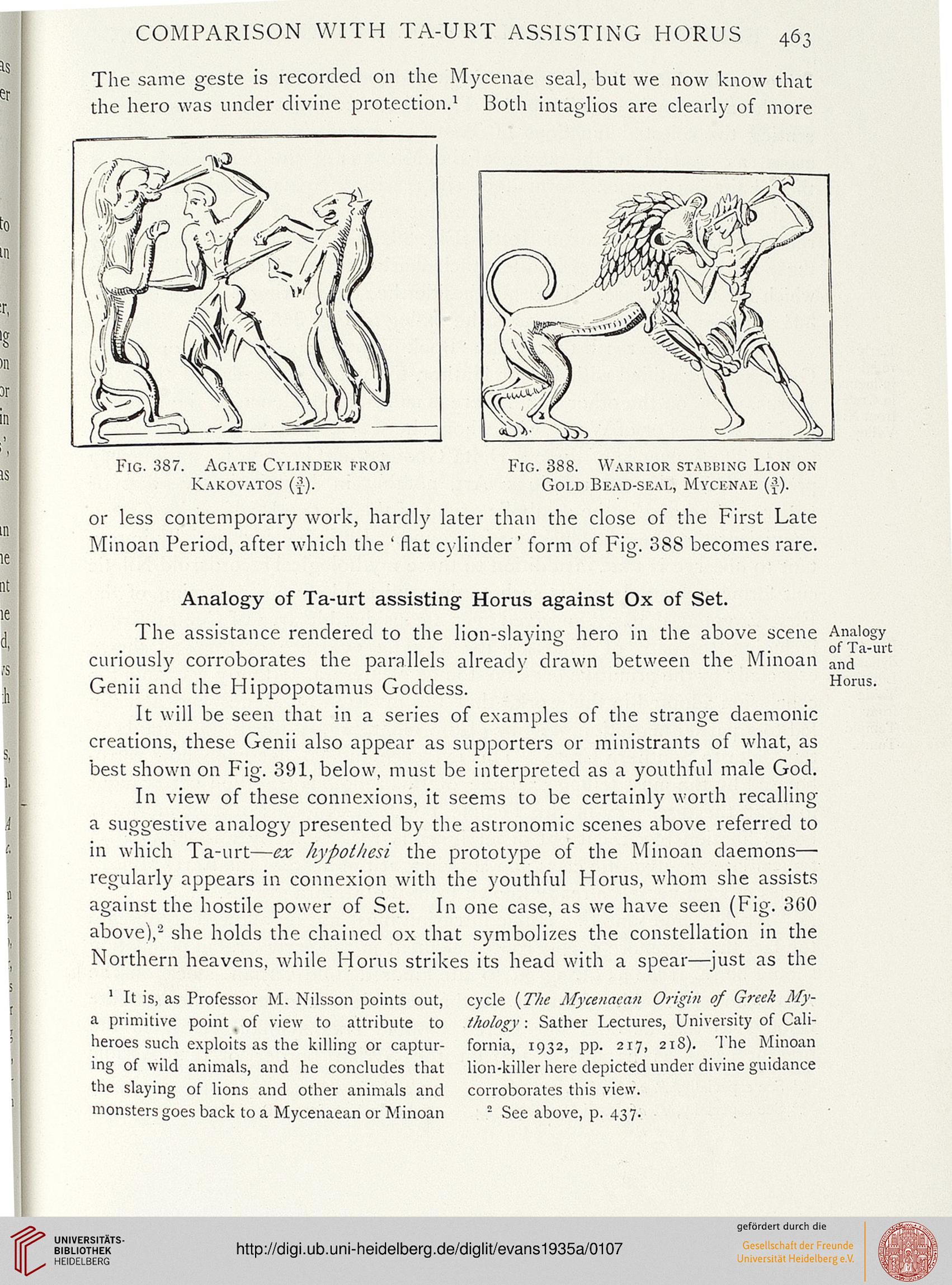COMPARISON WITH TA-URT ASSISTING HORUS 463
The same geste is recorded on the Mycenae seal, but we now know that
the hero was under divine protection.1 Both intaglios are clearly of more
Fig. 387. Agate Cylinder from
Kakovatos (r).
Fig. 388. Warrior stabbing Lion on
Gold Bead-seal, Mycenae (}).
or less contemporary work, hardly later than the close of the First Late
Minoan Period, after which the ' flat cylinder ' form of Fig;. 38S becomes rare.
and
Horus.
Analogy of Ta-urt assisting Horus against Ox of Set.
The assistance rendered to the lion-slaying hero in the above scene Analogy
curiously corroborates the parallels already drawn between the Minoan
Genii and the Hippopotamus Goddess.
It will be seen that in a series of examples of the strange daemonic
creations, these Genii also appear as supporters or ministrants of what, as
best shown on Fig. 391, below, must be interpreted as a youthful male God.
In view of these connexions, it seems to be certainly worth recalling"
a suggestive analogy presented by the astronomic scenes above referred to
in which Ta-urt—ex hypothesi the prototype of the Minoan daemons—
regularly appears in connexion with the youthful Horus, whom she assists
against the hostile power of Set. In one case, as we have seen (Fig. 360
above),2 she holds the chained ox that symbolizes the constellation in the
Northern heavens, while Horus strikes its head with a spear—just as the
1 It is, as Professor M. Nilsson points out,
a primitive point, of view to attribute to
heroes such exploits as the killing or captur-
ing of wild animals, and he concludes that
the slaying of lions and other animals and
monsters goes back to a Mycenaean or Minoan
cycle {The Mycenaean Origin of Greek My-
thology : Sather Lectures, University of Cali-
fornia, 1932, pp. 217, 2lS)- The Minoan
lion-killer here depicted under divine guidance
corroborates this view.
5 See above, p. 437.
The same geste is recorded on the Mycenae seal, but we now know that
the hero was under divine protection.1 Both intaglios are clearly of more
Fig. 387. Agate Cylinder from
Kakovatos (r).
Fig. 388. Warrior stabbing Lion on
Gold Bead-seal, Mycenae (}).
or less contemporary work, hardly later than the close of the First Late
Minoan Period, after which the ' flat cylinder ' form of Fig;. 38S becomes rare.
and
Horus.
Analogy of Ta-urt assisting Horus against Ox of Set.
The assistance rendered to the lion-slaying hero in the above scene Analogy
curiously corroborates the parallels already drawn between the Minoan
Genii and the Hippopotamus Goddess.
It will be seen that in a series of examples of the strange daemonic
creations, these Genii also appear as supporters or ministrants of what, as
best shown on Fig. 391, below, must be interpreted as a youthful male God.
In view of these connexions, it seems to be certainly worth recalling"
a suggestive analogy presented by the astronomic scenes above referred to
in which Ta-urt—ex hypothesi the prototype of the Minoan daemons—
regularly appears in connexion with the youthful Horus, whom she assists
against the hostile power of Set. In one case, as we have seen (Fig. 360
above),2 she holds the chained ox that symbolizes the constellation in the
Northern heavens, while Horus strikes its head with a spear—just as the
1 It is, as Professor M. Nilsson points out,
a primitive point, of view to attribute to
heroes such exploits as the killing or captur-
ing of wild animals, and he concludes that
the slaying of lions and other animals and
monsters goes back to a Mycenaean or Minoan
cycle {The Mycenaean Origin of Greek My-
thology : Sather Lectures, University of Cali-
fornia, 1932, pp. 217, 2lS)- The Minoan
lion-killer here depicted under divine guidance
corroborates this view.
5 See above, p. 437.





